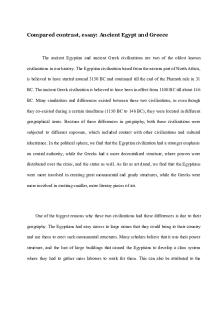Ancient Greece Part B PDF

| Title | Ancient Greece Part B |
|---|---|
| Course | Fashion Studies |
| Institution | High School - Canada |
| Pages | 2 |
| File Size | 44 KB |
| File Type | |
| Total Downloads | 63 |
| Total Views | 167 |
Summary
An assignment on fashion history and this chosen period is Ancient Greece, ...
Description
Ancient Greece Part B Chiton This was worn in the sixth century and was made of wool. Madder, saffron and/or died indigo. Over the breast were the folded edges of the upper garment and it folded to circle around the body. The arms were left bare and the open right side was held in place by a girdle. Over time, the garment grew wider and became known as the Doric Chiton. The over-fold deepened over time and it was concealed in the girdle. Himation A himation has weighted corners, is slung over the left shoulder and is a rectangular piece of wool. The right arm is let free and married women often wore the himation as a shawl. The himation had multiple purposes including serving as a blanket. Overtime, it evolved from plain to having embroidery, selvages and woven patterns. A bare left shoulder was considered a sign of barbarism so men would carefully wrap it around their shoulders. Veil Civilizations with eastern influences usually had women wearing veils. However, the women of ancient Greece wore them as well. Often, women would cover their face as well as their head. The veil was influenced by politics and power as it was more common for women with a higher status to cover their face and head. Epiblema The peplos or chiton were worn under the epiblema. It was essentially a shawl. Women wore it while walking outside of their homes. They were most commonly worn in the fall and were sewn in a multitude of different colours. In terms of politics and power, the more powerful you were, the more elaborate your epilblema was as officials, senators and anyone associated with the government often had different ones from the rest of the citizens. Peplos Common body length attire for women was what was Peplos was. The edge was folded down halfway and it was a long, tubular cloth. The tube was draped below the waist and the bottom was at the ankle. The peplos was vastly popular among females. An appearance of a second piece of clothing was generated from the peplos’ fold on the tube. During ancient Greek rituals, many girls were chosen to make sacred peploi. Tunic This was worn loosely by females or confined by a girdle. Often, girdles of different sizes would be woven together, and it would form the two in the tunic in a puckered interval. However, this fashion was only applied to short tunics as such marital exercises were incompatible with long petticoats. Males avoided wearing the tunic.
Works Cited Adhikari, Saugat, and Kostas Petalas. “Top 10 Famous Clothes in Ancient Greece.” Ancient History Lists, 25 Mar. 2019, www.ancienthistorylists.com/greek-history/top-10-famous-clothes-ancient-greece/. “The Ancient Greek Fashion History. Clothing in Ancient Greece.” World4, world4.eu/the-ancient-greekcostume/. Staff, Buzzle. “5 Types of Ancient Greek Clothing and Their Evolution Over Time.” Historyplex, Historyplex, 10 Mar. 2018, historyplex.com/ancient-greek-clothing....
Similar Free PDFs

Ancient Greece Part B
- 2 Pages

Death in Ancient Greece
- 6 Pages

Part Performance Readings - Part B
- 12 Pages

Remedies Part B
- 4 Pages
Popular Institutions
- Tinajero National High School - Annex
- Politeknik Caltex Riau
- Yokohama City University
- SGT University
- University of Al-Qadisiyah
- Divine Word College of Vigan
- Techniek College Rotterdam
- Universidade de Santiago
- Universiti Teknologi MARA Cawangan Johor Kampus Pasir Gudang
- Poltekkes Kemenkes Yogyakarta
- Baguio City National High School
- Colegio san marcos
- preparatoria uno
- Centro de Bachillerato Tecnológico Industrial y de Servicios No. 107
- Dalian Maritime University
- Quang Trung Secondary School
- Colegio Tecnológico en Informática
- Corporación Regional de Educación Superior
- Grupo CEDVA
- Dar Al Uloom University
- Centro de Estudios Preuniversitarios de la Universidad Nacional de Ingeniería
- 上智大学
- Aakash International School, Nuna Majara
- San Felipe Neri Catholic School
- Kang Chiao International School - New Taipei City
- Misamis Occidental National High School
- Institución Educativa Escuela Normal Juan Ladrilleros
- Kolehiyo ng Pantukan
- Batanes State College
- Instituto Continental
- Sekolah Menengah Kejuruan Kesehatan Kaltara (Tarakan)
- Colegio de La Inmaculada Concepcion - Cebu











